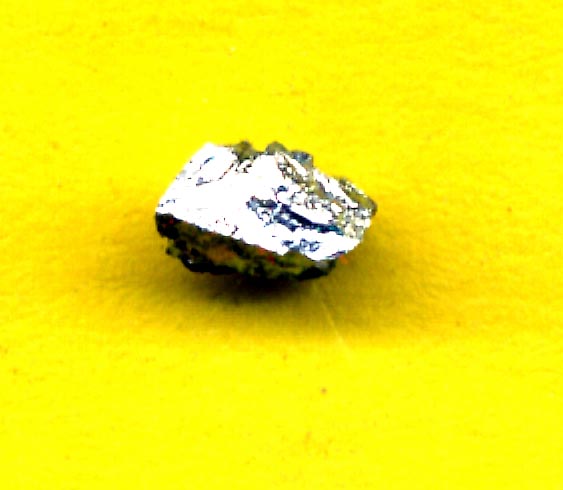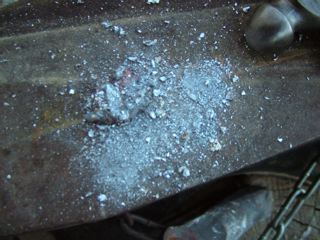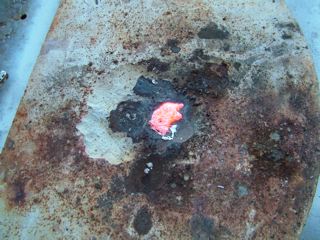The WiZard is In
International Hazard
    
Posts: 1617
Registered: 3-4-2010
Member Is Offline
Mood: No Mood
|
|
Things to do on a rainy day - intermetallic's
Gold-magnesium alloys. R. Vogel. Z. anorg. Chem., 1909, 63, 169-183.
In: — The Journal of the Society of Chemical Industry. 28 [10] 1041. October 15, 1909.
An extract.
In order to prepare the alloys, the magnesium was melted, and gold sheet added
as necessary. The union was always accompanied by a very large evolution of
heat, in some cases almost to explosiveness. The same characteristic occurs in
the alloy of gold with zinc and cadmium, and indeed forms a series in accordance
falling atomic weight. The miscibility of the gold with magnesium in the solid
state, with the formation of mixed crystals, is up to 3 per cent., and with zinc and
cadmium up to 5 per cent
The late Alexander P. Hardt, Incendiary Potential of Exothermic Intermetallic
Reactions, Lockheed Palo Alto Research Laboratory Report LMSC-D177523,
1971. Discusses a number of intermetallic reactions, none however, using Au.
Accepting carbon and silicon as metallic surprisingly high temperatures are
possible:
TiB2 3770o C
TiC 3600
ZrC 3800
NbSi2 3300
HfC 4200
-------
A Survey of Combustible Metals, Thermites, and Intermetallics
of Pyrotechnic Applications.
http://tinyurl.com/2f2bbj4
|
|
|
12AX7
Post Harlot
    
Posts: 4803
Registered: 8-3-2005
Location: oscillating
Member Is Offline
Mood: informative
|
|
I don't have an Au-Mg phase diagram, but Al-Au shows Al2Au ("aluminum auride") melting at 1330K.
Titanium and the other reactive metals burn quite excellently with anything on the right hand side. Borides, carbides, nitrides, oxides and fluorides
are all known, to say nothing of subsequent rows.
Tim
|
|
|
The WiZard is In
International Hazard
    
Posts: 1617
Registered: 3-4-2010
Member Is Offline
Mood: No Mood
|
|
Quote: Originally posted by 12AX7  | I don't have an Au-Mg phase diagram, but Al-Au shows Al2Au ("aluminum auride") melting at 1330K.
Titanium and the other reactive metals burn quite excellently with anything on the right hand side. Borides, carbides, nitrides, oxides and fluorides
are all known, to say nothing of subsequent rows.
Tim |
YEABUT coming from where ... the heat when gold
and magnesium dobe combined?
|
|
|
Mr. Wizard
International Hazard
    
Posts: 1042
Registered: 30-3-2003
Member Is Offline
Mood: No Mood
|
|
I made an 'alloy' of aluminum electrical wire and copper wire by melting the Copper in a bowl , with an oxygen-acetylene torch and adding an equal
weight (not sure now) of pure Al wire to the molten pool. I think I was trying for Cu3:Al2. The material melted and mixed quite well. On cooling it
surprised me by forming some silvery crystals which were quite pretty. When it cooled I was able to crush the material with a hammer and it made a
silvery smear on everything it was rubbed on. Some portions of it had almost a buttery texture. I never did anything more with it, as I threw it out
while cleaning up, and haven't tried it again. Maybe today?
|
|
|
JohnWW
International Hazard
    
Posts: 2849
Registered: 27-7-2004
Location: New Zealand
Member Is Offline
Mood: No Mood
|
|
The melting-point of Al is below that of Cu, so you could have made things easier by heating the Al to melting in the crucible first, and then adding
the Cu and steadily raising the temperature as more Cu was added. What you have made would be an "aluminium bronze", which usually contain more Cu
than Al, and have a fairly bright reddish color; they are harder than Sn or Pb bronzes and Zn brasses, but are more liable to corrosion.
|
|
|
Mr. Wizard
International Hazard
    
Posts: 1042
Registered: 30-3-2003
Member Is Offline
Mood: No Mood
|
|
Thanks for the tip on making Al bronze. It would be useful making any real quantity. Al bronze is probably a much more useful material than what I
made. It was very fragile and was more like a slush or stiff wax than a metal. It was very shiny and did not have any noticeable reddish color which
surprised me. Since then I have wondered if I could have used it to coat plaster or wooden forms to produce a conductive coating for electroplating. I
meant to make some today, but other distractions kept me busy, and now the 'one who must be obeyed' wants to go to supper. Maybe pictures in a day or
so..
|
|
|
12AX7
Post Harlot
    
Posts: 4803
Registered: 8-3-2005
Location: oscillating
Member Is Offline
Mood: informative
|
|
Nope! You want to melt the copper first so you are certain it is dissolved. After about 33% aluminum has been added (about half, by volume!), the
melting point is lower and not as much heat is required.
I have made aluminum bronze before (C635 comes to mind, don't know if that's right), it has a yellowish cast and is very strong (and rather difficult
to cast, as it shrinks quite suddenly on freezing). Any alloys between 10% Cu and 85% Cu are completely useless; if you mistakenly made one of these,
that could explain your bad results.
I have also made aluminum master alloy before, which is 50%wt, almost pure Al2Cu. This intermetallic has a melting point slightly less than pure
aluminum's, despite its large fraction of copper. It is as brittle as Mr. Wizard describes.
Tim
|
|
|
Mr. Wizard
International Hazard
    
Posts: 1042
Registered: 30-3-2003
Member Is Offline
Mood: No Mood
|
|
I wish I had noted the ratio I used to get the soft crunchy version. I made some tonight 6 grams Cu/ 6 grams Al and did not get a good mix even though
it was all melted. The material was very brittle, like glass, and could be crushed by rocking a hammer head on it. It also did not put a silvery shine
on anything.
Attached is a 5 mm chunk I put on a scanner bed to image. It has a very sharp fractured appearance. As you can see on the fractured piece the Copper
and Aluminum did not mix completely.
I was shooting for Al2Cu with 6.3 grams Cu and 5.4 grams Al, but the only handy scale would not measure fractions of grams, so I ended up with 6 grams
of each.
[Edited on 4-5-2010 by Mr. Wizard]
[Edited on 4-5-2010 by Mr. Wizard]
[Edited on 4-5-2010 by Mr. Wizard]
 
|
|
|
Mr. Wizard
International Hazard
    
Posts: 1042
Registered: 30-3-2003
Member Is Offline
Mood: No Mood
|
|
Multiple attachments are a challenge. The name on the previous should be hot cu6Al6. For some reason I'm not able to add the three photos.
[Edited on 4-5-2010 by Mr. Wizard]
|
|
|
12AX7
Post Harlot
    
Posts: 4803
Registered: 8-3-2005
Location: oscillating
Member Is Offline
Mood: informative
|
|
Also, the file has no extension and thinks it's a PDF for some reason.
Tim
|
|
|
Mr. Wizard
International Hazard
    
Posts: 1042
Registered: 30-3-2003
Member Is Offline
Mood: No Mood
|
|
Thanks Tim, that was the reason. While I was changing the name of the picture file I had dropped the .jpg. The shard on the yellow paper is about 5
mm in size and as brittle as glass. The original melt is shown crushed on an anvil. You can just see a hit of red in the non crushed section. I did
not get a good mix when I heated it on a ceramic plate with my oxygen acetylene torch. The materials were all electrical grade copper and aluminum
wire. I melted the Cu first and then fed in the Al. I did not get a good mix with this method.
Picture below is the red hot mass cooling.

[Edited on 4-5-2010 by Mr. Wizard]
[Edited on 4-5-2010 by Mr. Wizard]
|
|
|